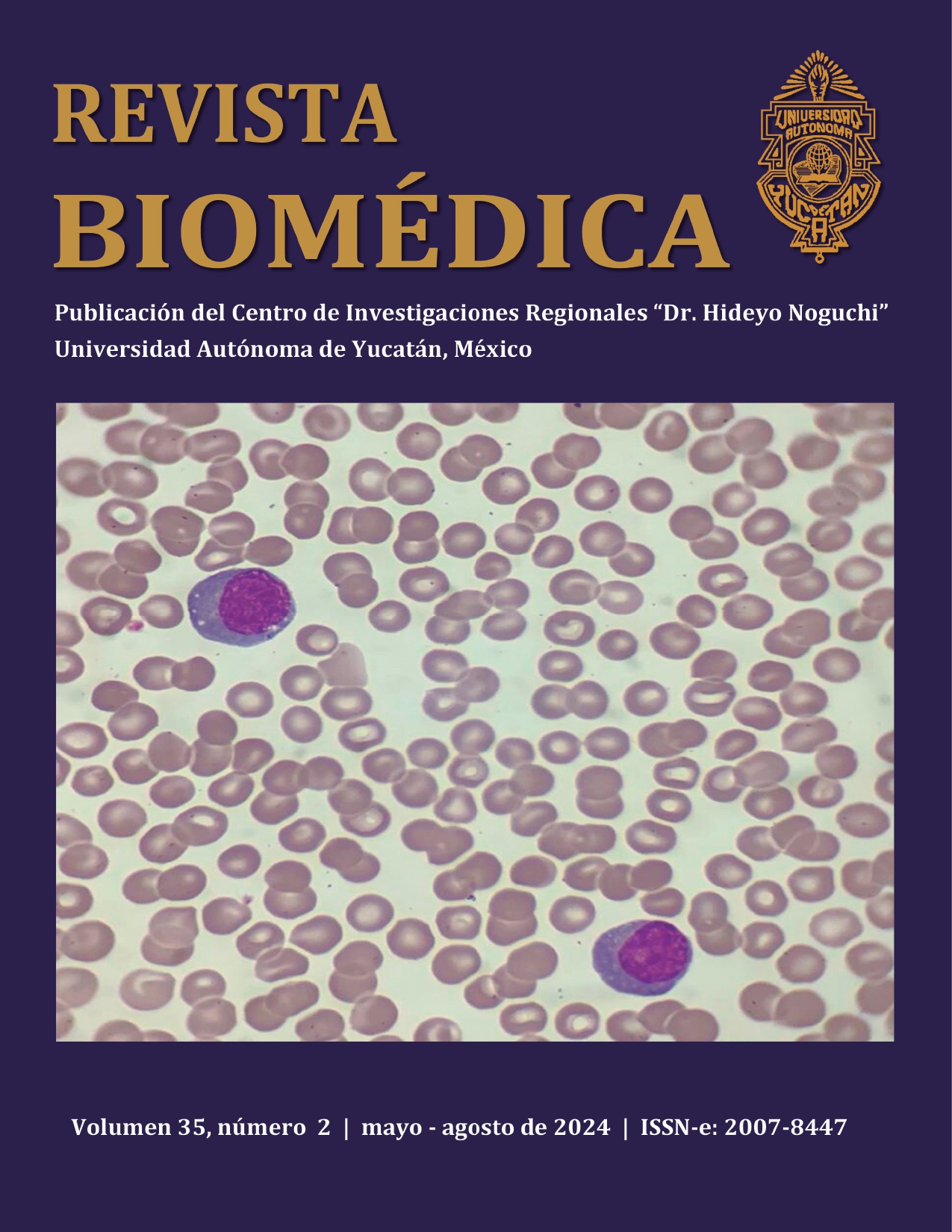Use of PCR assay to detect Leishmania-DNA in saliva from patients suffering American Cutaneous Leishmaniasis
Resumen
Introduction: American cutaneous leishmaniasis (ACL) affects over one million people annually worldwide. Its spread enables Leishmania-parasites invading the skin, mucosa, and body-fluids including saliva. Detection of Leishmania-DNA in saliva, has been proposed as a non-invasive method.
Objective: To evaluate the use of multiplex conventional PCR-assay in saliva to identify Leishmania-DNA from patients infected with ACL.
Materials and Methods: Individuals with ACL were selected to evaluate a PCR-based saliva tool to identify Leishmania-DNA, 18 with active lesions and 3 with scars of previous healed ulcers, evaluated 2 years post-treatment. Saliva from 3 negative controls were included for comparison. Saliva samples (1 mL-each) were collected to be processed before, during and after treatment.
Results: Amplification of Leishmania-DNA in saliva from patients with healed and active lesions, revealed Leishmania braziliensis in 78% pre-treated and 28% during and after the treatment.
Conclusions: PCR-assay resulted useful identifying L. braziliensis in saliva from ACL-patients.
Referencias
Añez N, Cazorla D, Nieves E, Chataing B, Castro M, Yarbuh AL. Epidemiología de la leishmaniasis en el Estado Mérida, Venezuela. I.-Diversidad y dispersión de especies flebotominas en tres pisos altitudinales y su posible role en la transmisión de la enfermedad. Mem Inst Oswaldo Cruz. 1988. 83(4):455-63. https://doi.org/10.1590/S0074-02761988000400011
Añez N, Rojas A, Scorza-Dagert JV, Morales C. Successful treatment against American cutaneous leishmaniasis by intralesional infiltration of a generic antimonial compound-lidocaine combination. A follow up study. Acta Trop. 2018. Sep;185:261-66. doi: 10.1016/j.actatropica.2018.06.001.
Costa JML, Saldanha ACR, Nascimento D, Sampaio G, Carneiro F, Lisboa E, et al. Clinical modalities, diagnosis and therapeutic approach of the tegumentary leishmaniasis in Brazil. Gaz Méd Bahia. 2009. 79(3):70-83. http://gmbahia.ufba.br/index.php/gmbahia/article/viewfile/1033/1009
Weigle K, Saravia NG. Natural history, clinical evolution, and the host-parasite interaction in New World cutaneous leishmaniasis. Clin Dermatol. 1996. 14(5):433-50. https://doi.org/10.1016/0738-081X(96)00036-3
Mebrahtu YB, Van Eys E, Guizani I, Lawyer P, Pamba H, Koech D, et al. Human cutaneous leishmaniasis caused by Leishmania donovani s.l. in Kenya.Trans R Soc Trop Med Hyg, 1993. 87(5):598-601, https://doi.org/10.1016/0035-9203(93)90101-U
Guevara P, Ramírez J L, Rojas E, Scorza JV, González N, Añez N. Leishmania braziliensis in blood 30 years after cure. Lancet. 1993. 341:1341. https://doi.org/10.1016/0140-6736(93)90845-8
Guevara P, Rojas E, Gonzalez N, Scorza JV, Añez N, Valera M, et al. Presence of Leishmania braziliensis in blood samples from cured patients or at different stages of immunotherapy. Clin Diagn Lab Immunol. 1994. 1:385-89. doi: 10.1128/cdli.1.4.385-389.1994.
Añez N, Gonzalez C, Lugo de Yarbuh A, Rojas A, Crisante G, Ramírez JL. et al. Association of trauma with Leishmania parasite recall. Clinical and experimental evidences. Bol Malariol Salud Ambient. 2000. 40(1-2):13-20.
Corvalan FH, Sampaio RNR, Brustoloni YM, Andreotti R, Lima Júnior MSC. DNA identification of Leishmania (Viannia) braziliensis in human saliva from a patient with American cutaneous leishmaniasis. J Venom Anim Toxins Incl Trop Dis. 2011. 17(1): 98-102. doi:10.1590/S1678-91992011000100013.
Phumee A, Kraivichian K, Chusri S, Noppakun N, Vibhagool A, Sanprasert V, et al. Detection of Leishmania siamensis DNA in saliva by polymerase chain reaction. Am J Trop Med Hyg. 2013. 89(5):899-905. doi: 10.4269/ajtmh.12-0612.
Siriyasatien P, Chusri S, Kraivichian K, Jariyapan N, Hortiwakul T, Silpapojakul K, et al. Early detection of novel Leishmania species DNA in the saliva of two HIV-infected patients. BMC Infect Dis. 2016. 16:89. https://doi.org/10.1186/s12879-016-1433-2.
Pandey N, Siripattanapipong S, Leelayoova S, Manomat J, Mungthin M, Tan-Ariya P, et al. Detection of Leishmania DNA in saliva among patients with HIV/AIDS in Trang Province, southern Thailand. Acta Trop. 2018. Sep;185:294-300. doi: 10.1016/j.actatropica.2018.06.006.
Brito MEF, Almeida EL, Medeiros ACR, Werkhäuser RP, Alexandre JLA, Sá BSLF, et al. Leishmania (Viannia) braziliensis isolated from the saliva of patients in a cutaneous leishmaniasis-endemic area of northeastern Brazil. Mem Inst Oswaldo Cruz. 2018. Feb. 5;113(4): e170250. doi: 10.1590/0074-02760170250.
Harris E, Kropp G, Belli A, Rodríguez B, Agabian N. Single-step multiplex PCR for characterization of New World Leishmania complexes. J Clin Microbiol. 1998. 36 (7):1989-1995. doi: 10.1128/jcm.36.7.1989-1995.1998
Rojas A, Crisante G, García P, Carrero J, Añez N. Leishmania braziliensis-GPI anchored membrane proteins as an alternative tool for specific sero-diagnosis of active American cutaneous leishmaniasis. Am J Microbiol Biotechnol. 2015. 2(4):57-63. http://article.aascit.org/file/pdf/9190765.pdf
Premoli-de-Percoco G, Gonzalez N, Añez N, Guevara P, Ramírez JL. PCR detection of specific Leishmania-DNA in patients with periodontal disease. Pathologica. 2002. Feb; 94(1):28-31. PMID: 11912876.
Añez N, Crisante G, Araujo S, Añez M, Rojas A, Parada H. Detection and significance of Trypanosoma cruzi persistence in inflamed gingival foci in Chagas disease. Int J Clin Med Res. 2015a. 2(2):8-13. http://article.aascit.org/file/pdf/9060783.pdf
Lee YH, Wong DT. Saliva: an emerging biofluid for early detection of diseases. Am J Dent. 2009. Aug;22(4):241-8. PMID: 19824562; PMCID: PMC2860957.
Lima DP, Diniz DG, Moimaz SA, Sumida DH, Okamoto AC. Saliva: reflection of the body. Int J Infect Dis. 2010. Mar;14(3): e184-8. doi: 10.1016/j.ijid.2009.04.022.
Javaid MA, Ahmed AS, Durand R, Tran SD. Saliva as a diagnostic tool for oral and systemic diseases. J Oral Biol Craniofac Res. 2016. Jan-Apr;6(1):66-75. doi: 10.1016/j.jobcr.2015.08.006.
Enlaces refback
- No hay ningún enlace refback.













